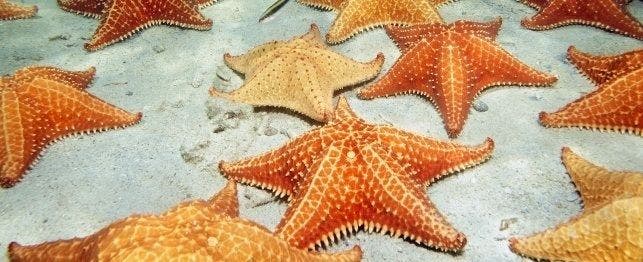
Choosing a Starfish
Starfish are a fun and popular addition to the saltwater aquarium, but would it surprise you to know that they are not a fish at all? They belong to a group of animals called Echinoderms, a term that refers to their hard spiny skeletons. These animals are invertebrates. They lack a backbone and are noted for their radial symmetry, which means that their arms radiate from a central point. The top of the starfish consists of a protective external skeleton, but turn it over and you will see a distinct mouth located at the center of the body and numerous tube feet, which are used for locomotion, respiration and feeding.
Behavior
Starfish live on the floor of the ocean. They are active predators and feed on shellfish such as mussels, clams and oysters but they will also feed as scavengers. When you keep them as specimens in an aquarium, you need to provide small bits of food that sink to the bottom of the tank. Take care not to overfeed and foul the water of the tank with uneaten food. Starfish should get along fine with saltwater tankmates, provided you are not keeping any tasty clams or mussels. A starfish can use its tiny tube feet to pry open the shells and make a meal for themselves. They are too slow to be a threat to fish, and other animals leave starfish alone due to their hard spiny exoskeleton.
Reproduction
Starfish are unlikely to reproduce in the home aquarium by spawning but they can reproduce asexually. They have the ability to regenerate a damaged body part and in some cases the damaged fragment may become a functional second starfish.
Husbandry
Starfish aren’t too picky about tank conditions. They do appreciate rocks to climb and like to cling on the surfaces. You may see them climbing the tank walls. Don’t let them perch themselves close to the heating element where they may suffer a burn. You will also need to monitor them to make sure they are eating. That is not always an easy task since their mouths are not visible. If their color begins to fade or their spiny skeletons become soft, water quality, lighting conditions and nutrition may all be factors.